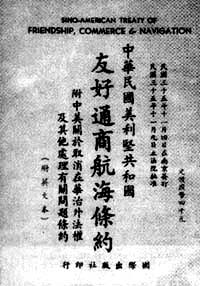Sino-American Treaty of Friendship, Commerce and Navigation
In 1946, the KMT government signed a treaty with the government of United States which included a trade pact, maritime provisions, the establishment of consulates and other issues.
Following World War II, civil war broke out in China in 1946. To gain support from the US, the KMT government sent foreign minister Wang Shijie to sign the Sino-American Treaty of Friendship, Commerce and Navigation with US ambassador John Leighton Stuart on November 4.
The main provisions of the treaty were:
1. US citizens were given the right to reside, travel and do business in China, including the right to engage in manufacturing, education, and religious and charitable activities. The treaty removed existing restrictions on hiring laborers and leasing property.
2. US commodities were to be given no less favorable treatment than those accorded to commodities of any other country.
3. US vessels, including warships, were given the right to visit any Chinese port, and travel through Chinese waters, including areas that had previously been closed to foreign commerce and navigation.
On the surface, the treaty was fair to both China and the U.S. But in practice only the United States benefited from its provisions since China was backward in both the economy and maritime transportation. The treaty provoked a wave of astonishment throughout China. On February 1, 1947, the Central Committee of the Communist Party of China declared it would refuse to acknowledge any treacherous treaties signed by Kuomintang government, adding that "the measures taken by the KMT government, are entirely contrary to the will of the Chinese people, and are pushing China into the chaos of civil war, betrayal, colonization, and collapse."
